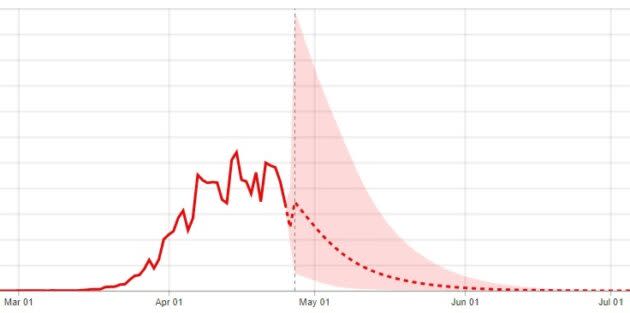Coronavirus modelers raise projected U.S. death toll and lengthen state-by-state recovery timeline

The timeline has slipped to the right and the projected death toll has trended upward in a new projection from the creators of a closely watched computer model for the course of the U.S. coronavirus outbreak.
Tonight’s update from the University of Washington’s Institute for Health Metrics and Evaluation raises the outlook for the cumulative U.S. death toll through Aug. 4 from the 67,641 fatalities projected on April 22 to a new figure of 74,073.
That’s creeping closer to the death toll of 81,114 that IHME laid out in its first projection, way back in late March. Since then, the figures have gone as high as 93,000 and as low as 60,000.
What’s more, there’s a wide interval of uncertainty at the 95% confidence level. For example, the latest projection gives a range between 56,563 and 130,666 deaths.
The variations in IHME’s projections over the past month have sparked criticism from other modelers, who point to the unorthodox, almost purely mathematical method that’s used for the model. IHME’s researchers counter that they’re continually tweaking their model, based on the new data that they receive.
That’s the case for the higher projections in the latest forecast.
“At least part of this increase is due to many states experiencing flatter and thus longer epidemic peaks,” the IHME team said in its latest update. “Further, updated data indicate that daily COVID-19 deaths are not falling very quickly after the peak, leading to longer tails for many states’ epidemic curves.”
Coronavirus Live Updates: The latest COVID-19 developments in Seattle and the world of tech
The specificity of each projection has appealed to policymakers, including President Donald Trump and his coronavirus task force. Just today, Trump cited the death count from last week’s IHME projection of the U.S. death toll, saying that “we’re probably heading to 60,000, 70,000.”
“It’s far too many,” Trump added. “One person is far too many.”
IHME also estimates when each state might be able to relax social distancing restrictions, based on the date when newly reported daily COVID-19 cases are projected to fall below one case per 1 million population in a given state.
The latest projection generally gives later dates for easing restrictions. For example, Washington state’s transition date has slipped from May 28 to May 30. Florida’s new date of June 21 is a week later than the date that was projected less than a week ago. North Dakota’s last-in-the-nation date has slipped from July 19 to July 20.
For what it’s worth, the earliest date is May 10, for West Virginia.
Some states have significantly jumped the gun, if IHME’s projections are any guide. Georgia, for example, has given the go-ahead for the reopening of hair salons and tattoo parlors, among other businesses, even though the institute projects that social distancing shouldn’t be eased there until June 28.
Computer modelers at the Bellevue, Wash.-based Institute for Disease Modeling say that easing social distancing too early runs the risk of touching off rebounds in COVID-19 infections that could exceed earlier peaks.
The projections from IHME assume that states will continue to ban large gatherings, and that adequate systems will be put in place for virus testing, contact tracing and isolation of potential COVID-19 patients. As if we needed any more bad news, epidemiologists say such systems don’t meet the necessary standards in most parts of the country.
For the record, Johns Hopkins University’s authoritative coronavirus tracker currently reports more than 988,000 confirmed COVID-19 cases in the United States, including more than 56,000 deaths. IHME projects a Washington state death toll of 841 through Aug. 4, while the latest figures from the Washington State Department of Health report 765 deaths to date.
Update for 2:50 p.m. PT April 29: The institute revised its figures yet again on April 28. Those projections put the total death toll through Aug. 4 at 72,860, slightly less than the figure from the day before. But the death toll for Washington state is projected to be 860, slightly higher than the previous estimate. Washington’s new date for easing social distancing is May 31.
For the record, JHU’s current U.S. death toll is 60,475, and the Washington State Department of Health lists 786 fatalities. And for what it’s worth, JHU’s tally of confirmed COVID-19 cases in the U.S. exceeds 1 million.
Update for 6:15 p.m. PT April 30: Another revision was made April 29. Projected U.S. death toll is 72,433, projected Washington state death toll is 877, and Washington state’s projected optimal date for easing social distancing is June 2. IHME says it hasn’t yet factored in how an early relaxation of social distancing in some states would affect the projections. JHU’s current count for confirmed COVID-19 cases in the U.S. is 1,069,534, and its tally of U.S. deaths is 62,951. Washington state public health officials list 814 fatalities.
More from GeekWire:
Coronavirus computer modelers revise their dates for easing state shutdowns
New pandemic projection puts U.S. death toll at nearly 135,000, due to less social distancing
Univ. of Washington researchers predict 80,000 COVID-19 deaths in U.S. by July
Another month? Computer modelers estimate how much longer coronavirus shutdowns should last
